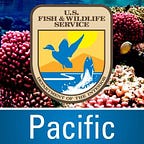Benton Pang shares cultural traditions in celebration of Asian American, Native Hawaiian and Pacific Islander Heritage Month
By Jan Peterson, for the U.S. Fish and Wildlife Service’s Pacific Region
May is a very special month in Hawai‘i. It begins on May 1 with Lei Day, a holiday on which everyone is encouraged to share the spirit of aloha by giving and receiving lei.
That date also marks the launch of the nationally observed Asian American, Native Hawaiian and Pacific Islander Heritage Month, a month in which the United States’ 24 million Asian and 1.7 million Native Hawaiian and other Pacific Island peoples are celebrated.
The U.S. Fish and Wildlife Service is fortunate to have many Asian Americans, Native Hawaiians and Pacific Islanders in its work force. Among them is ethnobotanist Benton Pang, who is the conservation partnerships team manager for the Pacific Islands Fish and Wildlife Office (PIFWO), on the island of O’ahu.
Pang, who is Native Hawaiian, began his career as an ethnobotanist, after earning his master’s degree from the University of Hawai‘i studying tapa (Hawaiian bark cloth), which is used for clothing and hula. For his doctorate, Pang studied how Native Hawaiians use the dry forest floor for making canoes. While he spends his days now — 20 years later — overseeing the conservation partnerships programs, Pang continues to enjoy sharing his deep understanding of Hawaiian plant species and their traditional uses, particularly lei making.
A while back, Pang and others got the idea to offer lei-making workshops to fellow federal employees in celebration of AANHPI Month. “We’ve been doing this for probably the past 10 or 15 years,” Pang says. “It started with my background being in botany and wanting to share a little bit of my culture with the office.”
Pang explains the lei is a type of adornment that dates back to as early as 500 to 1,300 A.D. Found throughout the Pacific Islands, lei are worn not just around the neck or head, but also around wrists and ankles. In modern times, Americans largely associate lei with greetings, but there are many varieties of lei with equally varied meanings.
Sometimes, Pang explains, lei made of shells are used in hula. “In hula, they would wear a lei made of shells, because the shells, when they knock against one another, they would make a sound. That sound associated with dancing hula became part of the hula.
“Then there were lei worn by royalty, the people of the highest stature. Usually, the feather lei was worn around the head. The lei that would go around the neck was made of strands of hair and whale’s tooth. That particular lei is called the niho palaoa, which is translated to mean adornment made of whale’s tooth.”
Pang says anyone spotted wearing a niho palaoa and a feather lei were immediately identified as being royalty or of similarly high rank. “It took quite a bit of energy and someone of great stature to tell other people to go out into the forest, wait for these birds, catch them, take a couple of feathers and use those to make a lei,” he says.
Pang says the niho palaoa and feather lei are examples of permanent lei, which stay in a family and are handed down through generations. His mother, he says, has some treasured shell lei, made with tiny Ni‘ihau shells collected from beaches. “It takes a long time to pick them on the beach, sort them out and then string them into a lei. And today, to buy one strand of Ni‘ihau shell lei may cost $1,000 or more. You might see some families that have six strands of Ni‘ihau shell lei because they’ve been handed down through the family,” Pang says.
Pang and other Service staff will hold a lei workshop, which is open to anyone who works in the federal building where Service offices are housed. Staff bring flowers and foliage from their gardens and assist Pang in teaching lei-making techniques. Pang says the workshops attract as many as 40 people and while some are lured in by fliers throughout the building, others sometimes follow their noses. “When you walk down the hall, you can smell the fragrance of the plumeria and other Hawaiian flowers, so people are just kind of attracted to see what’s going on,” Pang says.
There are a variety of techniques used to make lei, but Pang says the workshops focus on the easiest, kui, which employs a long needle and string.
But Pang teaches attendees more than technique. He talks about the plants traditionally used in making lei and the spiritual aspects of making, giving and disposing of lei.
“I emphasize in the class, when you make the lei, part of your spirit is woven into the lei, so you’re giving some of your spirit to other person,” he explains. “When you receive a lei, don’t throw it into the trash can. Dispose of it properly. If you have a garden, compost it, or put it back into the forest where you collected flowers. It’s a sign of respect and giving the spirit back to the forest.”
After the lei workshop, attendees are given the opportunity to donate their lei to the Boy Scouts of America, who will use them for a very special purpose.
“On Memorial Day, the scouts put lei and a U.S. flag on each gravesite at National Memorial Cemetery of the Pacific (at Punchbowl Crater). It’s a really nice way of honoring our veterans on Memorial Day and also teaching a Hawaiian tradition,” Pang says.
###
The Service strives to build a workforce that reflects the public that we serve, creating a workplace where all backgrounds, abilities, beliefs, genders and orientations are welcome and valued for the array of ideas that they bring towards fulfilling the Service’s mission.
